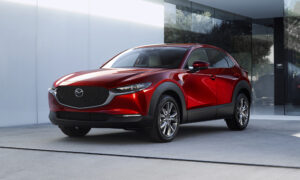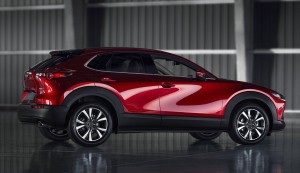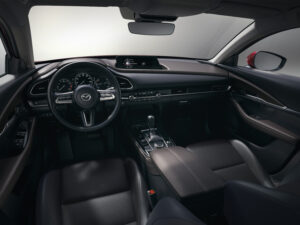

Have you ever heard an enthusiast or automotive journalist refer to a vehicle as ‘a real driver’s car?’ It’s usually meant as a compliment. A way to signify to the other True Believers out there that this is a vehicle worth their consideration. While it might not have all the bells and whistles of the competition, it does the basics really well. Ride, handling, steering and comfort. I’m willing to bet that most vehicle that previously fit into this category were either sports cars or sporty sedans. But if there were ever ‘a real driver’s SUV/Crossover’ the Mazda CX-30 is it.
The CX-30 is small, which is one of the only reasons it fits into the ‘driver’s SUV’ category. It’s inherently lower than other SUVs and that means it doesn’t feel top-heavy in a turn. A shorter wheelbase and overall well balanced body help contribute to good handling. Like a sports car, the CX-30 seems to rotate about its center. Not only does this make it feel more responsive, it gives the driver more confidence since they feel like they know what the vehicle is going to do.
In the U.S. the CX-30 is available with two 2.5L engines. One is naturally aspirated and generates 191 horsepower and the other, which is the version we tested, is turbocharged and makes up to 250 horsepower. Mazda tuned this setup to provide a lot of punch at low speeds. And that’s reflected in the max torque, 320 lb-ft, which is generated from 2,000-2,500 RPM. It feels like it has more to give than other vehicles we’ve driven in this class.

Comfort is another key in ‘a driver’s car.’ While they’re certainly not going to have the smoothest ride, you don’t want to feel burned out and sore after 45 minutes of driving either. And the CX-30 has a nice set of seats with a number of adjustments. Add in that it sits higher than a sports car or sporty sedan and the ride is even better compared to one of them. But here’s the place where it will concede some sporty prowess to the other low-slug cars.
While the average consumer might not think an interior plays much into the drivability of a car, we think it’s a huge part. Surface details, lights, knobs and colorful screen can all detract a driver’s attention from the road. But the CX-30 is simple. It features a layered dashboard with instrumentation for the driver and a screen in the middle for infotainment. I think Mazda relies a little too heavily on a large rotary knob for most of its controls because it makes navigating menus take longer, but overall the driver has a clean, unobstructed view of what’s in front of them.

With all this praise I’m heaping on Mazda you might wonder why its sales aren’t better. Truth be told, I feel like every time I write about Mazda it’s the same thing; this is a great driving car. So, the sales thing has always perplexed me a bit too. Here’s what I think is going on. As I said before Mazda tunes its cars to provide better punch at slow speeds, but that also knocks fuel economy, which puts it further down comparison lists. Another factor is styling. Mazda SUVs have more of a fastback rear end, which gives them a sporty appearance, but cuts into cargo space. That again moves them down comparison lists. Lastly, is exposure. While, I see Mazda commercials here and there, I can think of only one Mazda dealership that I pass on a somewhat regular basis. And not knowing where to go for service plays a role in people’s purchase decisions.
Price as Tested: $35,750
–Sean McElroy
Follow us on social media:

John McElroy is an influential thought leader in the automotive industry. He is a journalist, lecturer, commentator and entrepreneur. He created “Autoline Daily,” the first industry webcast of industry news and analysis.




